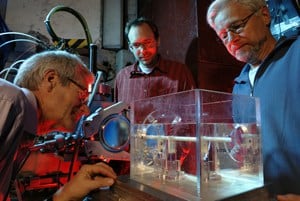A beam of antiprotons should be four times better at destroying tumours than current proton-beam therapies, claim physicists at CERN. The discovery could lead to new cancer-treatment techniques that minimize the damage done to healthy tissue surrounding tumours (Radiother. Oncol. 2006 doi:10.1016/j.radonc.2006.09.012).

Proton-beam therapy is a very effective way of destroying tumour cells in the body because protons deposit most of their energy at a precise depth in human tissue. This depth is a function of proton energy, which can be set to minimize the energy absorbed by healthy tissue surrounding a tumour.
Antiprotons should deliver the same precision with an added benefit — when an antiproton nears the end of its range, it will annihilate with a neutron or a proton, depositing additional energy and boosting the radiation dose delivered to the target area. Some of the fragments produced from this energy release could go on to destroy adjacent tumour cells.
Researchers working on CERN’s Antiproton Cell Experiment (ACE) have confirmed this hypothesis by irradiating hamster cells suspended in gelatine with beams of protons or antiprotons. The researchers then measured the fraction of surviving cells after irradiation as a function of depth.
The team compared cell survival within the target region (the tumour) to cell survival in the area in front of the target region (healthy tissue). They concluded that antiproton annihilation kills nearly four times as many target cells than proton therapy, while inflicting the same damage on healthy tissue.
“We have taken the first step towards a novel treatment for cancer,” said Michael Doser, who is a physicist at CERN. “The results show that antiprotons are four times as effective as protons at terminating live cells. Although it still has to be compared with other existing methods, it is a breakthrough in this area of investigation. “
ACE spokesperson Michael Holzscheiter of the US company Pbar Labs LLC explained: “To achieve the same level of damage to cells at the target area one needs four times fewer antiprotons than protons. This significantly reduces the damage to the cells along the entrance channel of the beam for antiprotons compared with protons.”
While initial results are certainly favourable, the researchers admit that clinical applications are still a decade or more away. For starters, antiprotons can only be produced using high-energy particle accelerators. And currently, CERN’s Antiproton Decelerator is the only facility in the world that can generate an antiproton beam of sufficiently low energy and high quality for this type of application.



